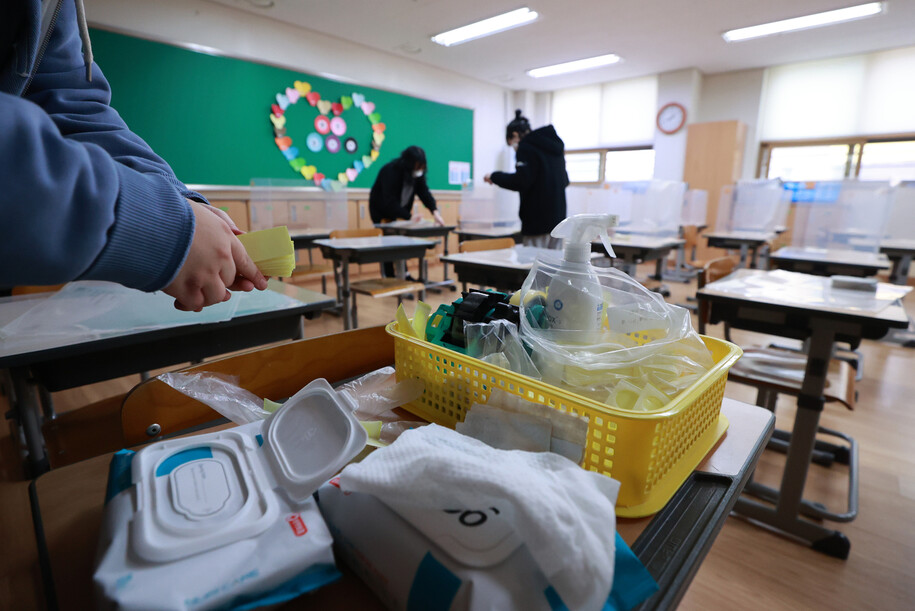Democratic Research Institute’s report on’Roadmap for Restoring the Education Vacancy in Coronaval’
Proposal of’Expanding Schools’… Also raised the need for’compensation education’

Before the opening of the new semester in March, on the afternoon of the 25th at Eonnam Elementary School in Seocho-gu, Seoul, the classroom desk screen is installed and the desk and screen are cleaned with disinfectant solution. In the first week of the new semester, all students attend school sequentially at different times in order to adjust to school life. yunhap news
While “expanding school” is considered the most appropriate means to fill the educational gap caused by Corona 19, a proposal was made to give “high school priority” starting with students who are most urgent to attend school, such as students who are vulnerable to domestic violence or children of essential workers. In addition, the Democratic Research Institute, a policy researcher under the Democratic Party, issued a report (policy briefing) titled “Coronaval Education Vacant Recovery Roadmap-Implications for the US’ Corona 19 Learning Loss Measurement Data for Korea” on the 23rd. It proposed a policy direction to respond to the education gap. The report said, “The educational gap caused by Corona 19 is a problem of’learning loss’ accumulated over the existing educational gap of students,” and he was concerned about the possibility of the emergence of’Coronavirus education deficit generation’. It is characterized by the fact that all students suffer deficits due to the absence of a school, and accordingly, the existing gap is deepened. For this reason, the report’s main argument is that an approach is needed to make up for the overall deficit, not just to support the lagging students. According to the American McKinsey & Company paper cited in the report, in October last year, elementary school students in the United States learned only 87% of’reading’ and 67% of’math’ compared to previous years. These are deficits corresponding to 1.5 and 3 months, respectively, and it is said that the deficit is greater for people of color. Another McKinsey & Company thesis predicted that if the school is not attended until June this year in the United States, about 10 months of learning deficit will occur, but if full school attendance, 5 months of learning deficit will occur. The report also pointed to’expanding stable school attendance’ as the main policy direction, and argued that measures to reduce the spread of the Corona 19 virus are necessary, such as recommending that teachers be given vaccines first and undergo regular tests. In Korea, as remote classes have been held since Corona 19, A large number of vacant positions in schools beyond the scope of’loss of education’ appeared. Although distance learning can be difficult to some extent, the school’s ability to care for and develop students in a comprehensive dimension such as life, health, relationships, and emotions could not be replaced. Accordingly, the report suggested that, above all else, to secure more school days, “Give priority to students who need them most.” In the context of an infectious disease epidemic, resources for attending school are limited due to lack of space and manpower. If students are able to attend school from urgent students, resources can be allocated appropriately, and class sizes can be reduced to ensure that both distance and school classes can be managed. For example, students subject to special education, students lacking in learning space, Internet, and devices, multicultural students, students vulnerable to domestic violence, and multi-child students are ranked first. Let’s consider giving priority to school attendance by classifying the students who do not have a second priority. Currently, our education authorities are targeting some grades such as kindergarten students, 1st and 2nd graders of elementary school, and 3rd graders of high school. The report also said, “In general, it is appropriate to consider the priorities of attending school in the order of kindergarteners and lower elementary school students, elementary and senior high school students, and middle and high school students.” However, he stressed the necessity of giving priority not only for each grade, but also for each student, saying, “For all students, it is necessary to identify students who are urgent to attend school and conduct a survey to identify any difficulties in remote classes.”

Captured’the order of students urgently in school’ as an example in the Democratic Research Institute report. Sources are Emma Dorn, Frédéric Panier, Nina Probst, & Jimmy Sarakatsannis (2020). Back to school: A framework for remote and hybrid learning amid COVID-19, Mckinsey & Company.
The report also raised the need for’compensation education’. Although remote classes were held in the Corona 19 situation, it was not enough to make up for the deficit in school classes. It means that the deficit must be compensated for by using various means, such as extending the number of days or hours of the class, delaying or rearranging the curriculum. The report pointed out, “Considering that the curriculum itself is designed as a spiral (accumulation of learning), there is an urgent need for a policy to make up for the academic losses that students have not learned.” In addition, some states in the United States, such as Texas, plan to extend the study time from 180 days to 210 days, and in Singapore, they plan to extend the school hours of elementary schools. In an education-related report published by the Organization for Economic Cooperation and Development (OECD) last year, “recovery education in diagnosing learning gaps and responding to learning losses” was cited as the main task. Research Fellow Lee Gyeong-ah, who wrote the report, said, “There is insufficient data to empirically verify the educational gap that appeared according to Corona 19. Therefore, it tends to flow only as a countermeasure in the way of supporting the existing students with poor basic education. It is imperative to specifically identify and fill in the gaps experienced by all students overall.” By Choi Won-hyung, staff reporter [email protected]
